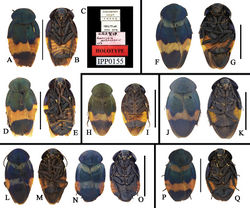Eucorydia tangi
| Notice: | This page is derived from the original publication listed below, whose author(s) should always be credited. Further contributors may edit and improve the content of this page and, consequently, need to be credited as well (see page history). Any assessment of factual correctness requires a careful review of the original article as well as of subsequent contributions.
If you are uncertain whether your planned contribution is correct or not, we suggest that you use the associated discussion page instead of editing the page directly. This page should be cited as follows (rationale):
Citation formats to copy and paste
BibTeX: @article{Qiu2017ZooKeys, RIS/ Endnote: TY - JOUR Wikipedia/ Citizendium: <ref name="Qiu2017ZooKeys">{{Citation See also the citation download page at the journal. |
Ordo: Blattodea
Familia: Corydiidae
Genus: Eucorydia
Name
Eucorydia tangi Qiu & Che & Wang, 2017 sp. n. – Wikispecies link – ZooBank link – Pensoft Profile
Type material
HOLOTYPE: CHINA: Guizhou: Male (SWU, ex SHNU), Lijiaba [李家坝], Mayanghe Natural Reserve [麻阳河自然保护区], Yanhe County [沿河县], 700m, 7.VI.2007, Liang Tang leg. PARATYPES: CHINA: Guizhou: 5 males (GZU), Daheba [大河坝], Yanhe County [沿河县], 450–700m, 5–12.VI.2007, Qiong-Zhang Song leg.
Diagnosis
This species resembles Eucorydia guilinensis sp. n., but can be distinguished from the latter by the following characters: 1) body larger (15.9–16.3 mm) and broader (8.6–8.8 mm), while body small (13.8–14.2 mm) and narrow (7.0–7.2 mm) in E. guilinensis; 2) the white pubescence on tegmina is mainly limited to the suture of left tegmen and 1/3 of basal anal area on both tegmina, while the pubescence more widely distributed at the base of tegmina in E. guilinensis; 3) the concave part of supra-anal plate more straight (Fig. 10C, No. 1-2), while more round in E. guilinensis (Fig. 8D, No. 1-2); 4) the appendage sclerite with basal left protruded, distal margin of the protruded part straight (Fig. 10C, No. 5), while the appendage sclerite with basal left protruded and strongely curved toward posterior (Fig. 8D, No. 5).
Description
Male: Measurements (mm): body length 12.7–13.2, overall length 15.9–16.3, pronotum length×width 3.9–4.1×6.8–7.0, tegmen length 12.6–12.8. Median size, broad, generally metallic green with orange band (Fig. 7J–K).
Head metallic greenish black, vertex with black pubescence. Pronotum metallic greenish blue entire, with short white pubescence, margins with black setae. Tegmen short and broad, metallic greenish blue, in resting position, the distal half of tegmina with a transverse orange band, occupying nearly 1/7 of the tegmen length, apical portion of the tegmen metallic bluish brown; surface of the basal edges of the tegmina, the sutural margin of left tegmen, and the orange band covered with short white pubescence. Wing transparent, slightly brownish. Legs dark brown, with blackish pubescence, spines on the legs brown.
Abdomen in ventral view brownish black, lateral margins orange except the last four sternites; in dorsal view, terga purplish black, T3-T5 orange laterally. Supra-anal plate dark brown, hind margin concave, cerci dark brown, short (Fig. 10C, No. 1-2); subgenital plate with robust styli.
Genitalia (Fig. 10C): L3 slender, curved, apex with a distinct hook; the appendage sclerite with basal left protruding, distal margin of the protruded part straight, distal portion with a bud-like process; R2 round, basal left with a shallow protruding, shape as in Fig. 10C, No. 6.
Female unknown.
Etymology
This species is named in honor of Mr. Liang Tang (SHNU), the collector of the holotype.
Distribution
China: Guizhou.
Original Description
- Qiu, L; Che, Y; Wang, Z; 2017: Revision of Eucorydia Hebard, 1929 from China, with notes on the genus and species worldwide (Blattodea, Corydioidea, Corydiidae) ZooKeys, (709): 17-56. doi
Images
|


